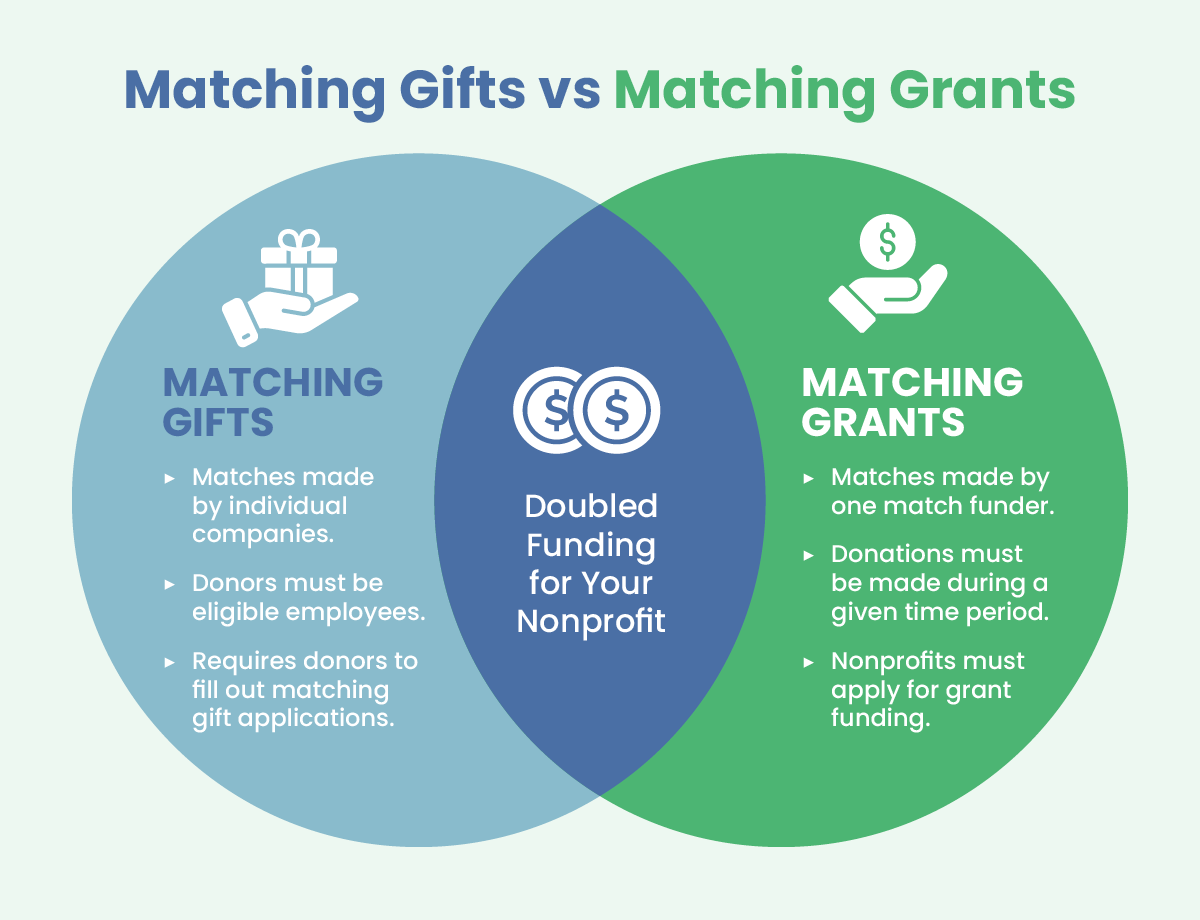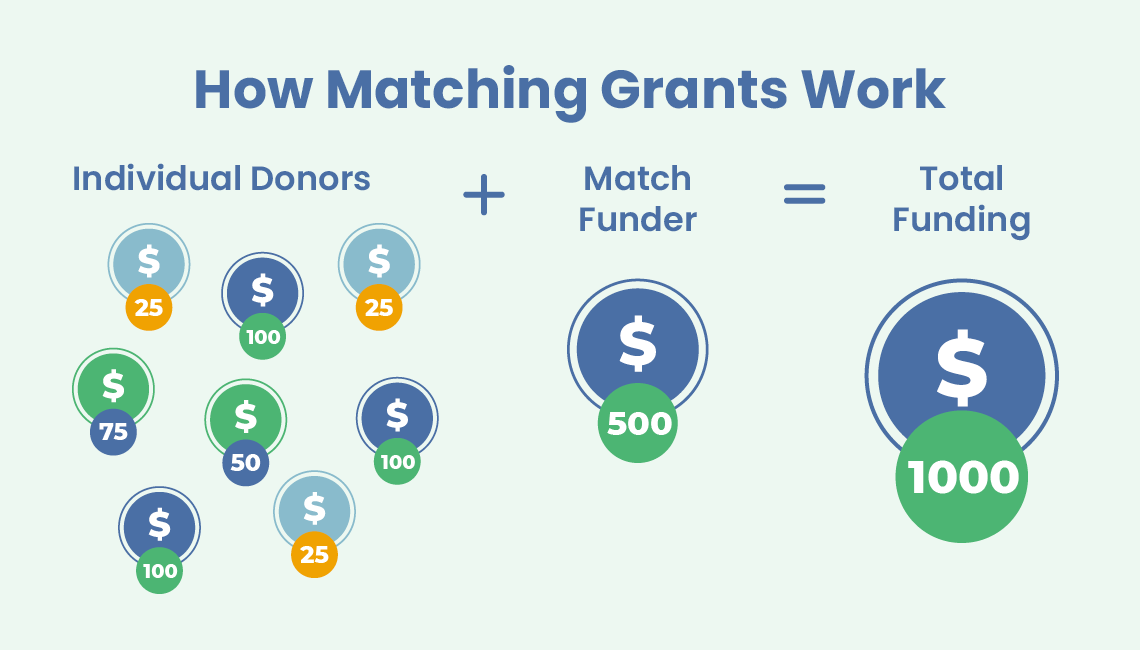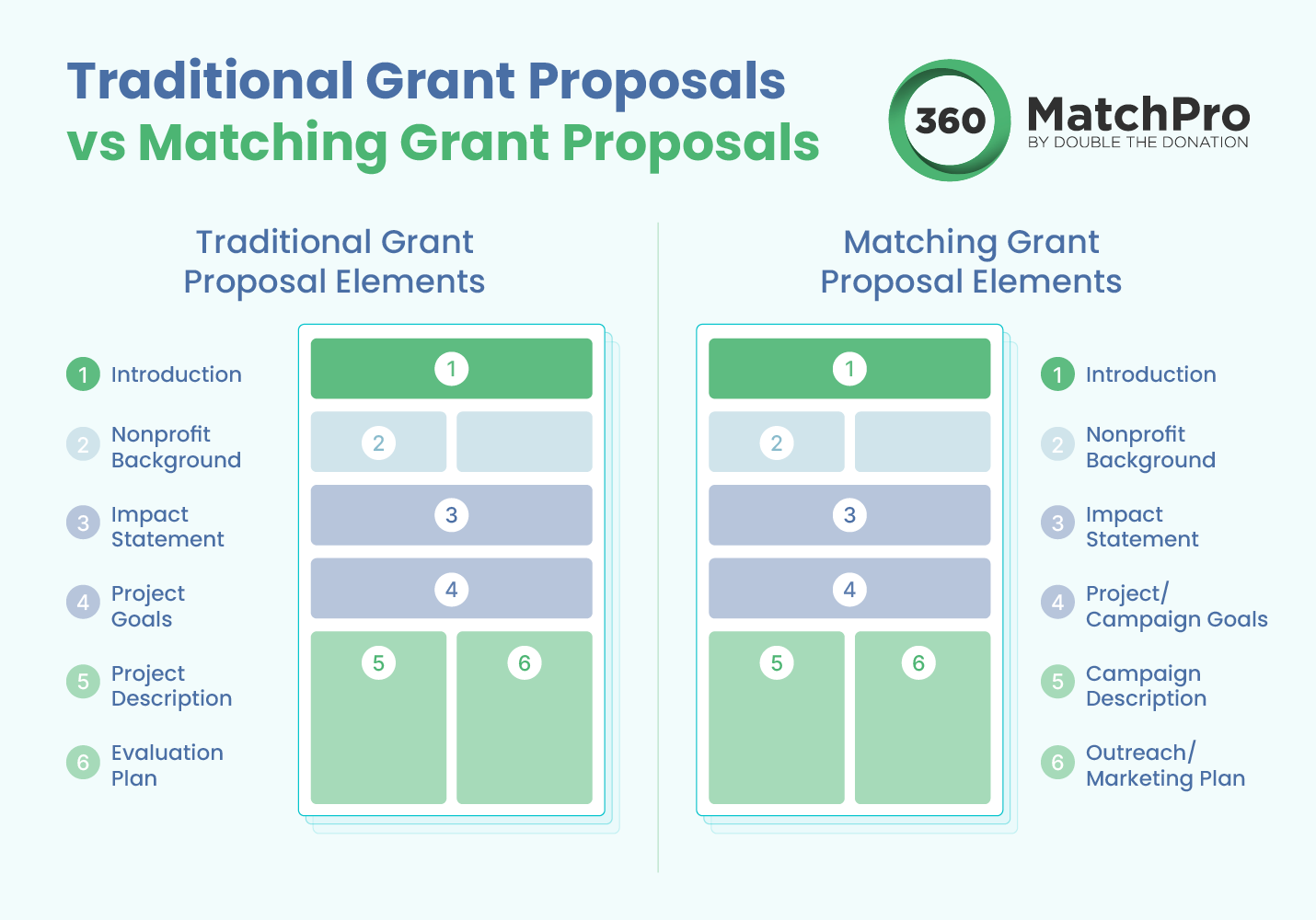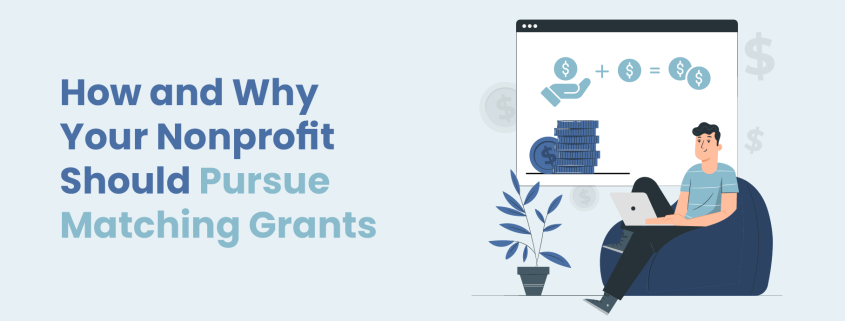How and Why Your Nonprofit Should Pursue Matching Grants
From monetary donations to volunteer support, corporate social responsibility (or CSR) comes in many forms. But no matter the exact kind of support, all CSR programs share the same objective: to help your nonprofit achieve its mission.
Rather than just handing out support, one type of CSR program promises to help nonprofits by supplementing their fundraising efforts. This CSR program is known as matching grants, and earning one of those contributions can improve your nonprofit’s fundraising performance by leaps and bounds. In this guide, we’ll dive into these funding opportunities by exploring:
Before exploring how your nonprofit can earn and leverage matching grants, let’s first explore the basics of what these donations are.
Matching Grants FAQ
What are matching grants?
Corporate matching grants are a type of corporate philanthropy in which a company agrees to match the donations a nonprofit raises. For example, a business might agree to match all donations a nonprofit earns on GivingTuesday. If the nonprofit raises $5,000, the business would donate $5,000 as well, for a total of $10,000 raised. Additionally, matching grants can also be provided by foundations.
Matching grants are similar to challenge gifts in that your nonprofit must do its own fundraising to earn benefits. However, while challenge gifts require nonprofits to hit specific fundraising targets, matching grants usually have looser restrictions and often do not require nonprofits to hit a minimum fundraising amount. This means that if your nonprofit’s fundraising falls short for a challenge gift, you will receive no benefit, whereas if your fundraiser underperforms during a matching grant, the donations you did earn will still be matched.
How are matching grants different from matching gifts?
Matching grants and matching gifts have similar names but are actually quite different. While both programs involve businesses helping double specific donations to your nonprofit, there are many differences between these two funding opportunities, including:

- Who is matching donations? For matching gifts, donations are made by various companies, whereas nonprofits usually only have one matching grant active at a time, and it comes from just one business or foundation.
- Who can have their gift matched? To qualify for a matching gift, donors must work for businesses that offer a matching gift program. In contrast, to qualify for a matching grant, donations can come from anyone but need to be made to a specific campaign or during a specific time.
- Who applies for funding? For your nonprofit to earn matching gifts, individual donors must apply for them. For matching grants, the nonprofit must apply.
Both matching gifts and matching grants have their advantages over the other, and nonprofits should pursue both opportunities when possible.
For instance, nonprofits can earn matching gift revenue at any time, while matching grants require direct cooperation with a business or foundation and usually only apply to donations made during a short period. However, matching gifts are highly individualized and require direct marketing to eligible supporters, whereas matching grants can be marketed to your entire donor base to drive fundraising results quickly.
What are the types of matching grants?
The structure of your nonprofit’s matching grant is determined by the agreement between your organization and the funding entity. For instance, a few types of matching grants include:

- Monetary. The most common and straightforward type of matching grants involves a business or foundation agreeing to match monetary donations made to a specific campaign or during a set period.
- In-Kind. Rather than matching monetary contributions, in-kind matching grants ask nonprofits to estimate the value of their goods and services, such as staff time, volunteer hours, and non-cash donations. The grantor will then provide the estimated monetary value to your nonprofit.
- Volunteer Hours. Similar to in-kind matching grants, volunteer hour grants involve calculating the value of the hours your volunteers contribute. For example, a nonprofit might follow current estimates that a volunteer hour is worth $33.49, meaning a supporter who volunteers 10 hours is worth almost $335. The matching grant funder would then donate the total amount that your volunteer hours are determined to be worth.
- Other Grants. To encourage nonprofits to apply for grants, some organizations offer to match the funds provided through other grants. For example, your nonprofit might earn a $5,000 grant from one foundation, $2,000 from a government program, and $8,000 from a business for a total of $15,000. The organization providing the matching grant would then match these grant amounts for a total of $30,000.
Some types of matching grants share similarities with other types of giving programs. For instance, volunteer hour matching grants have quite a bit in common with corporate volunteer grants.
To earn a volunteer grant, individual supporters must check whether their employer offers a volunteer grant program. If so, they can fill out an application requesting a donation to your nonprofit based on the number of hours they volunteered.
Like matching gifts, volunteer grants are easier for nonprofits to access than matching grants but also need to be sorted out individually for each supporter. This is because volunteer grant and matching gift program requirements vary from company to company. To help all supporters find and apply for these programs, nonprofits should invest in matching gift software.
Matching Grant Benefits
Matching grants require nonprofits to actively fundraise, leading some organizations to question how the benefits compare to traditional grants and other giving programs like matching gifts and volunteer grants.
A few benefits of matching grants include:
- Extra funding. Ultimately, matching grants are funding opportunities. Whether your nonprofit earns a swell of support or fundraising totals remain static, you’ll still earn revenue from your grantor’s match.
- Increased donor support. Matching grants can motivate your supporters to give more than they normally would. In fact, 84% of donors state they are more likely to give if a match is offered, and 1 in 3 indicate they would make a larger donation if there’s a match opportunity.
- Potential partnerships. Successfully earning and following through on a matching grant indicates to your partner organization that your nonprofit is reliable and worthy of future support. Plus, when reaching out to other corporations and foundations for grant opportunities, you can share your success story to appear more reputable.
Different matching grant arrangements are more beneficial than others. For example, while a 1:1 match ratio is the norm, some businesses and foundations may be willing to match your funding at higher ratios. This might be 2:1, 3:1, or even higher depending on your grantor.
How Matching Grants Work
After coming to an agreement with your grantor about the match ratio and funding time frame, your nonprofit needs to take the following steps:
- Promote your matching grant opportunity. To maximize your matching grant, kick your fundraising efforts up a notch. This might involve hosting an event, launching a media blitz, or leveraging new campaign strategies, like peer-to-peer fundraising. Remember to publicize the match opportunity to motivate donors to give more to maximize their impact.
- Document donations. Keep careful records of incoming donations. Your grantor will base their support on the amount you report having raised, so ensure your documentation is clear, organized, and minimizes ambiguity.
- Submit results. Share the records for all donations made during the match period with your grantor.
- Receive funding. After reviewing your reported donation, your grantor will follow through on their agreed-upon match ratio. Remember that some grantors will only provide restricted funding, and there may be stipulations for how your match funds can be spent.

Because matching grants make your supporters’ donations go further, get creative with how you boost donor activity while a matching grant is active.
For example, you might have your major gift officers reach out to major donor prospects to inform them about your match grant and recommend it as an optimal time or reason to give. Or, you might partner with an online influencer to reach a brand new audience and use your matching grant as a way to attract first-time donors.
How to Earn a Matching Grant
Research opportunities.
If your nonprofit has an ongoing partnership with a business or foundation, you may be able to propose and work out a matching grant agreement. However, most nonprofits will need to find and apply for matching grant opportunities.
You can discover these opportunities with grant research platforms. Most grant research tools are databases or websites that compile information on grant opportunities offered by foundations, government agencies, and corporations.
To use a grant research tool to find matching grant opportunities, follow these steps:
Determine what type of research tool you need.
Most grant databases can be sorted into one of three categories:
- Government grant databases. Government grants are, as the name implies, offered by government entities. Keep in mind that local government opportunities may not always appear on general government grant databases but can be found by checking your city or town’s website.
- Foundation grant databases. Foundation grant databases primarily house foundations’ information but also sometimes have corporate grants, as well. Foundation grant databases are often the only way to find grant opportunities from foundations that do not have websites.
- Research grant databases. These databases are primarily for academic and scientific research projects and are not applicable to nonprofits seeking match grant funding.
Keep in mind that most grant databases require a subscription, and some fees can be quite expensive. To ensure these costs will be worthwhile, assess your nonprofit’s grant readiness before committing to research expenses.
Narrow search results.
Use your chosen grant database’s filters to narrow your search criteria. Most databases will provide search options based on location, grant type, grant size, application deadlines, and what types of nonprofits are eligible.
In your initial research, cast a wide net and then narrow your options down based on what opportunities seem most promising. If a grant opportunity does not match your nonprofit’s mission exactly, don’t abandon it outright. Remember, grantors often have specific missions of their own, and part of grant writing is framing your nonprofit’s mission and initiatives in such a way that they align with the grantmaker’s objectives.
Find the necessary information.
Grant databases provide details about specific grants, but usually, the most valuable information you can get from them is grantmakers’ contact information.
For grant opportunities with websites, continue your research by reading what the grantmaker has posted publicly about the grant and their philanthropic goals. For foundations without websites, grant databases can provide information about nonprofits they have funded in the past and who runs the foundation.
Pursuing grant opportunities for low-tech foundations can be a challenge, but building these relationships can pay off in the long run. Research conferences and conventions in your state related to grants, such as grant writing workshops. Think of these as opportunities to improve your grant applications and network with foundation representatives.
Write a matching grant proposal.
Matching gift proposals have a lot in common with other types of grant proposals. For example, both proposals will include an introduction, background on your nonprofit, and an impact statement.
However, a few common components unique to matching grant proposals include:

- Project/campaign goals. Grantors want to know what your nonprofit hopes to accomplish with their funding. However, matching grants require your nonprofit to run a fundraising campaign before acquiring funding. As such, provide a campaign goal for how much you hope to raise and have matched.
- Campaign description. Along with your campaign goal, provide details about your fundraising campaign. Doing so should show the grantor that your nonprofit is organized, has the capacity to run a successful fundraising campaign, and is aiming for a feasible campaign goal.
- Reporting. In typical grant proposals, nonprofits explain how they will assess the success of the program they plan to spend grant funding on. For a monetary matching grant, explain how your organization will document donations. For other types of matching grants, such as in-kind grants, explain your process for estimating the value of goods and services you will request equal funding for.
Like with any grant, ensure your team has adequate grant writing skills or work with a professional grant writer to complete your proposal. Matching grant proposals might also require input from multiple teams, such as your marketing and donor outreach departments.
Promote your match opportunity.
Once you’ve confirmed a matching grant opportunity, it’s time to kick your fundraising plans into high gear. To attract as many donors as possible and maximize gifts for your match grant, market this opportunity by:
- Focusing on donor impact. Matching grants tend to see higher levels of support because they help mid-level donors make a bigger impact than they would normally be able to. In all promotion material, share your grantor’s match ratio and what your nonprofit will be able to accomplish with your donors’ increased support.
- Instilling a sense of urgency. Matching grants usually have tight deadlines for when donations qualify. Be sure to share these deadlines with supporters to instill a sense of urgency and encourage them to contribute before it’s too late.
- Creating visually striking marketing materials. During a matching grant campaign, you need to get as many donor eyes on your nonprofit as quickly as possible. Create content on social media, your website, and in emails that will catch your donors’ attention. This might involve using photographs, bold illustrations, or videos.
When launching your marketing campaign, follow your brand guide to create consistent materials across all platforms. While you may feel the urgency to produce as many marketing messages as quickly as possible, keeping a high level of quality and brand cohesiveness can help you earn new supporters and retain them even after your matching grant deadline.
Report back to your funder.
Some grantmakers require grantees to provide follow-up reports about how funding was used and what it accomplished.
If your grantor has these requirements, prepare grant reports that go into detail about which programs were funded, how that funding benefited the program, and what accomplishments can be linked to the new funding.
You may also be asked to identify setbacks and missed opportunities in your grant report. Be honest in these sections but frame them as learning opportunities to reassure the grantor that your nonprofit is aware of any potential issues and is still a reputable grant recipient they should continue to fund.
More Matching Grant Resources
Matching grants help nonprofits increase funding by mobilizing their donor base, encouraging them to grow their audience, expand their marketing, and deepen donor relationships. In return, nonprofits can see their marketing and fundraising efforts doubled, if not tripled or even quadrupled!
To learn more about grant opportunities like matching grants and how to secure them, explore these resources:
- How to Secure Corporate Sponsorships: Find Your Perfect Fit. Many matching grant partnerships start as or lead to corporate sponsorships. Learn how to secure these opportunities.
- Matching Donation Challenges: How to Double Donors’ Impact. Dive deeper into matching grants, also known as matching donation challenges, to see how your team can get started.
- The Expert’s Guide to Corporate Matching Gift Programs. Learn more about employee matching gifts, and see how these programs can work hand in hand with matching grants!





